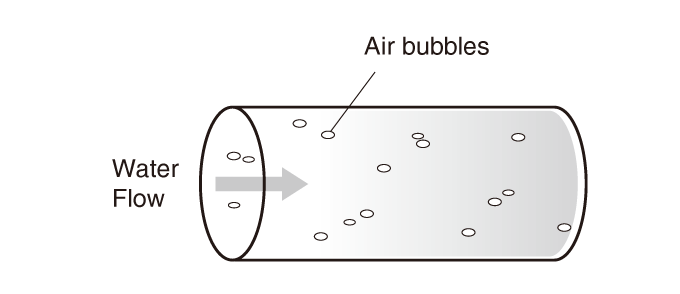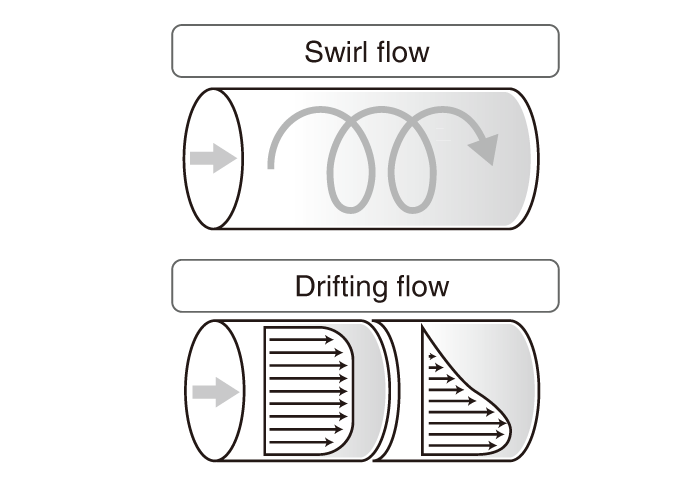The importance of understanding the cause of problems and taking appropriate measures
This section includes a summary of the causes of problems that tend to occur during flow control. Controlling flow requires constant flow monitoring and accurate measurement of flow rates. Problems that occur in flow meters or flow sensors can cause the product quality and efficiency to decrease and may lead to damage in the machine tools. Time-consuming maintenance and repairs will result not only in added costs but also to lost opportunities. For this reason, it is important to know the potential causes of trouble in order to prevent such trouble from occurring and to take appropriate measures to ensure proper flow control.
Slurry is a generic term for liquids that contain a uniform amount of solid particles throughout. This includes liquids that contain abrasives. The individual particles may wear down the inside of a flow meter or coagulate and cause clogging.
For flow meters that obstruct flow (i.e. karman vortex models), the slurry may cause axial wear and clogging. With an electromagnetic type flow meter, wear and clogging are minimal due to the free-flowing structure of the unit. Slurry detection is also possible using Coriolis type flow meters.
When dealing with an open system, it is possible for air to be introduced into the system during liquid intake. Air or impurities that have blended into the liquid cause bubbles. For a vortex flow meter, these bubbles disturb the creation of Karman vortices. For an ultrasonic flow meter, they inhibit the propagation of ultrasonic waves. Both cases result in malfunctions.
Since Coriolis type flow meters measure mass flow, they are unaffected by air bubbles. For electromagnetic type flow meters, bubbles can cause unstable flow readings. This is due to the fact that detection is based on volume and the bubbles are mistaken for fluid.

The distribution of flow velocity within circular piping is uniform after the flow has passed through a sufficient amount of straight pipe. On the other hand, the distribution of flow velocity becomes irregular due to bends in the piping or changes in the pipe diameter. Drifting occurs when the center of the distribution of flow velocity shifts away from the center of the pipe. Swirl flow occurs when the fluid rotates around a center axis, parallel to the direction of flow. Both swirling and drifting cause irregular distributions of flow velocity. Performing flow measurements in these conditions may lead to large measurement errors.
The degree of measurement error depends on the degree of irregularity in the distribution of flow velocity. Measurement performance can be improved by installing straight pipe sections upstream to make the distribution of flow velocity more uniform. (As a rough guide, the straight pipe section should be 5 times the bore diameter of the flow path.)

If the pulsations are large, the instantaneous flow may temporarily exceed the rated flow range of the flow meter. In this situation, the flow displayed on the flow meter is smaller than the actual flow. Volume type reciprocating pumps are known for generating large pulsations.
One possible way to reduce pulsations is by using a damper such as an accumulator. Also, if the pulsations cause fluctuations in the numeric values of the flow meter over time, increasing the flow meter's response time is effective at stabilizing the numeric values.
Piping vibration is commonly caused by machine vibration, opening and closing of valves, and even the transmission of the fluid itself.
With Coriolis and Karman vortex type flow meters, the flow may not be properly measured due to vibration. With electromagnetic and ultrasonic type flow meters, there are essentially no problems caused by vibration. (With ultrasonic type flow meters, there is such a large difference between the frequencies of the ultrasonic waves, piping vibrations can be ignored.)
CHAPTER 3
SOURCES OF TROUBLE FOR FLOW METERS
CHAPTER 4
PRESSURE LOSS
